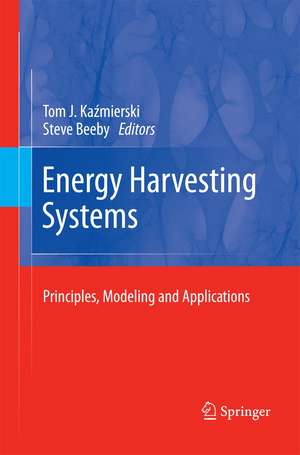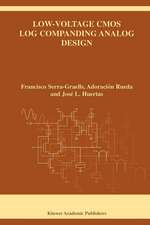Energy Harvesting Systems: Principles, Modeling and Applications
Editat de Tom J. Kaźmierski, Steve Beebyen Limba Engleză Paperback – 7 oct 2014
| Toate formatele și edițiile | Preț | Express |
|---|---|---|
| Paperback (1) | 721.01 lei 43-57 zile | |
| Springer – 7 oct 2014 | 721.01 lei 43-57 zile | |
| Hardback (1) | 640.71 lei 43-57 zile | |
| Springer – 10 noi 2010 | 640.71 lei 43-57 zile |
Preț: 721.01 lei
Preț vechi: 879.28 lei
-18% Nou
Puncte Express: 1082
Preț estimativ în valută:
137.98€ • 143.52$ • 113.91£
137.98€ • 143.52$ • 113.91£
Carte tipărită la comandă
Livrare economică 14-28 aprilie
Preluare comenzi: 021 569.72.76
Specificații
ISBN-13: 9781489998781
ISBN-10: 1489998780
Pagini: 176
Ilustrații: XI, 163 p.
Dimensiuni: 155 x 235 x 9 mm
Greutate: 0.25 kg
Ediția:2011
Editura: Springer
Colecția Springer
Locul publicării:New York, NY, United States
ISBN-10: 1489998780
Pagini: 176
Ilustrații: XI, 163 p.
Dimensiuni: 155 x 235 x 9 mm
Greutate: 0.25 kg
Ediția:2011
Editura: Springer
Colecția Springer
Locul publicării:New York, NY, United States
Public țintă
ResearchCuprins
The energy harvesting revolution.- Principles of kinetic energy harvesting.- Modeling, performance optimization and automated design of mixed-technology energy harvester systems.- Power simulation of ultra-low power sensor networks.- Battery free condition monitoring.- Remote sensing of car tire pressure.- Ultra low power wireless data transmission.
Textul de pe ultima copertă
Energy Harvesting Systems: Principles, Modelling and Applications Edited by: Tom Kazmierski Steve Beeby Kinetic energy harvesting converts movement or vibrations into electrical energy, enables battery free operation of wireless sensors and autonomous devices and facilitates their placement in locations where replacing a battery is not feasible or attractive. This book provides an introduction to operating principles and design methods of modern kinetic energy harvesting systems and explains the implications of harvested power on autonomous electronic systems design. It describes power conditioning circuits that maximize available energy and electronic systems design strategies that minimize power consumption and enable operation. The principles discussed in the book are supported by real case studies such as battery-less monitoring sensors at water waste processing plants, embedded battery-less sensors in automotive electronics and sensor-networks built with ultra-low power wireless nodes suitable for battery-less applications. •Provides a comprehensive introduction to energy harvesting systems;•Covers the operating principles, design methods and real applications;•Enables low-power autonomous electronic systems design.
Caracteristici
First comprehensive book on energy harvesting systems Covers the operating principles, design methods and real applications Enables low-power autonomous electronic systems design Includes supplementary material: sn.pub/extras



























